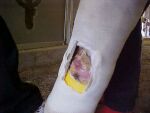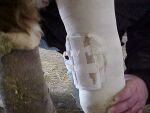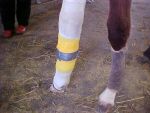|











|
- SH
Farana
- The "Baby Farana"
Story
|
 |
- The saga of SH Farana began long before
he was born. It started with my interest in finding horses with
close-up crosses to the great Kellogg stallion Farana #708 (*Nasik
x *Farasin). He was a stock horse of renown, and seemed to be
a positive influence in pedigrees when combined with Abu Farwa,
Alla Amarward, and other Reese Circle "greats." All
too often, though, it seemed that he was the "silent influence"
and was not linebred, so that horses with any high degree of
Farana blood were rare. Even as I utilized horses such as Lawmoss
(Lawseyn x Lawsouma, both out of the Farana daughter Farlouma)
in my breeding program, I began to be aware that tail male Farana
horses just simply were not to be found. Consequently, I started
to search for them.
-
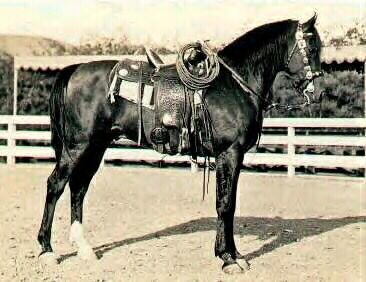
- Farana #708 (*Nasik
604 x *Farasin 615)
-
- Initially, I spent hours and hours combing
through the old Registry microfiches, identifying stallions of
an age that they might still be alive, that traced their tail
male line to Farana. I was only able to identify four. One could
not be tracked down. One is DRS Flaming Star, owned by Carole
Lee of northern Idaho--a very lovely stallion. But the other
two, a father-and-son combo, particularly intrigued me, because
not only did they trace in tail male line to Farana, but they
were also linebred to him. I received a wonderful letter from
the man who owned Arbe El Nafar, sending pictures and old farm
ads--but alas, Arbe had been gelded in his later years simply
due to lack of interest in traditional old lines and due to the
encroachment of suburbia on his owner's place. Later, however,
I heard from Jay and Bernice Corcoran, owners of Ibn El Nafar,
who not only had 5 crosses to Farana but also had close crosses
to two of Farana's full sisters and several other close relatives.
"Naffy" was alive and well--and intact!--but had had
a crippling injury as a foal. Nonetheless, I made the trek to
Palm Desert, near Victorville, CA, to see Naffy and his dam,
who was still alive at the time. To make a long story short,
he came home with me three years later on a breeding lease, in
declining health, but still proud, alert, and a pleasure to be
around.
-
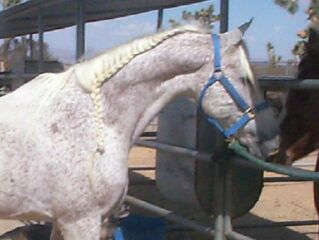
- Ibn El Nafar (Arbe El
Nafar [Nataf x Ake Ta Lisa] x Junamait [El Amait x Aulani Nisan])
-
- Naffy was unable to stand on his crippled
hind leg to cover mares, so we got a handful of mares in foal
to him by AI, collecting him while he stood with all four legs
on the ground. We lost him the following winter, but his last
efforts and our hard work were rewarded when we foaled out two
sons and two daughters. One son in particular (out of one of
our Lawmoss daughters, who herself has 4 crosses to Farana) was
a dandy bay colt--pretty, athletic, with the breathtaking movement
and self-carriage of his illustrious ancestor and an inquisitive
and in-your-pocket disposition, to boot! Of course, we had to
name him SH Farana.
-
- His first hurdle in life was a rather
stressful beginning. His dam was a maiden mare, and when I checked
her on the morning of July 3, 2002, she appeared to be near foaling.
No wax, nothing imminent--just looked close. So I came up to
the house, put up some pipe panels for her foaling pen, and decided
to duck into the house for a piece of toast and a glass of milk.
Half an hour after checking her, I went back down to the pasture
to bring her up to her "foaling pen"--and saw her off
by herself with a little set of tippy ears sticking up out of
the grass! The other mares had not yet discovered her, but they
did as soon as he got up--and I was home alone, with the task
of packing him out of the pasture with a dozen other broodmares
trying to steal him from me and his frustrated mama! Well, we
managed--but he and mama were pretty stressed out, which is never
an auspicious beginning. He nursed well, and all seemed fine
until he was 5 days old--when he broke with a case of navel ill
and a septic hock.
-
- Over the course of the next month, he
was on antibiotics several times a day and had his hock drained
4 times, but he was a trooper and a great little patient, and
didn't complain (much). The hock healed without incident, and
he was able to join his compatriots out in the "big world."
-
- Life seemed uneventful, and he was growing
up beautifully--he was the pasture clown, the friendly colt that
was into everything, and the one who stole everyone's heart.
Until I came home on a snowy winter's night in December, and
went out to feed, and found him standing pitifully by the fence,
one foreleg dangling uselessly, the cannon bone shattered from
an apparent kick wound. There was a gaping gash over the fracture
site, and jagged bone end were sticking out. My dreams for this
colt came crashing to the ground, and my first thought (other
than wanting to scream at the horror and injustice of it all)
was that it was dark and that I would need help to euthanize
him, as I was once again home alone. But I looked him in the
eye, and I could swear he was telling me that he just wasn't
ready to die.
-
- I called Dr. Todd Tibbitts, who had helped
me with his septic hock. Todd was tied up with a couple of other
emergencies--but he wondered if I might not be able to get it
splinted and get him into town to Dr. Renee Riggleman the next
morning, to see if it could be cast. I went back outside with
splint materials and a sedative, only to find that one of the
mares had bumped into him, and unable to walk, he had collapsed
over onto his back into an empty water tub--and was lying there
with his broken leg doubled completely over! Another dash to
the house, and another frantic call, this time to my neighbor,
who came dashing to my rescue within minutes--by which time I
had him sedated, had him started on antibiotics, and had a makeshift
splint on the leg. The neighbor and his daughter helped me drag
him out the gate, where I was able to reinforce the splint (roll
cotton, a rasp, and a track bandage) with a better splint (more
roll cotton, Vetrap, a 4" PVC pipe cut in half lengthwise,
more track bandage, and the last of my duct tape). I put up a
makeshift pipe panel pen for him and his mama, and spent a long,
chilly night checking on him, ensconced in an oversized horse
blanket and a down sleeping bag. Dr. Tibbitts made the trek out
first thing in the morning to help me load him for town, after
reinforcing my splint with additional duct tape, and pronounced
that he looked to be in awfully good shape, all things considered!
-
- Dr. Riggleman got x-rays taken first thing,
and was pretty pessimistic. The bone was literally shattered,
and the open wound meant that there was contamination at the
fracture site as well. His foot was also cold. She asked me twice
if I really wanted to "put him through this" but I
told her how determined he seemed to live, and that he had a
future as a breeding stallion, even if he didn't heal entirely
sound, and she agreed to try. He sailed through the casting procedure,
and as I was holding his foot to stretch his leg to set it, I
could feel it warming up in my hand--the circulation had apparently
been diminished, but not cut off.
-
- When he came out of anesthesia, we moved
him with his mama to Payback Arabians--much closer to town, for
cast changes, and a much better facility for him to stay during
what could turn out to be a long winter of recuperation. Because
of the open wound, we needed to change the cast frequently, so
that we could flush and treat the wound, and check its progress.
-
.jpg)
- SH Farana in his full-leg
cast, shortly after his accident
-
- In the first few days after his injury,
I searched the Internet for alternatives, should we be unsuccessful
in saving his leg. One of the contacts I made was a very helpful
man named Roy Scudamore, who runs a company called Equine
Prosthetics. Roy has kept in touch with me by e-mail throughout
the entire ordeal, and has given us all kinds of good pointers
in managing Farana's fracture. He encouraged us to do serial
cast changes even more frequently than we had originally planned,
and I think this has paid off. The initial cast change was encouraging--although
not much granulation had taken place, the wound looked healthy.
And most importantly, the lower leg was still alive. The second
had us down in the dumps--there was a lot of drainage, the wound
smelled bad, and what granulation tissue had formed did NOT look
good. We altered his antibiotic regimen, and dreaded the third
cast change. But lo and behold, it was somewhat better, and by
the fourth cast change, we began to have fairly healthy-looking
granulation tissue. And an x-ray in mid-January showed that we
had good bone healing started, and no evidence of infection!
We were on our way!
-
- But we still had more hurdles in store.
While I was out of town for a weekend, Melanie Johnson of Payback
Ranch came out one morning to find Baby Farana down, with diarrhea
soaking the stall, a heart rate of 128, no gut sounds, and purple
gums. Dr. Riggleman came straight out, and got an IV line started,
but didn't hold out much hope. Melanie hooked up her trailer
and got her neighbor and barn helper Robin to drive her rig with
her riding in the back with Farana, on icy roads in freezing
rain, to take him to the clinic. She then started trying to track
me down by phone so that I could talk to Dr. Riggleman directly.
When I got hold of her, she and I were in agreement; horses simply
do not survive episodes like this. We discussed at what point
to put him down, and how to dispose of his body. His discomfort
was under control on drugs, but we agreed that should she be
unable to control his pain, or should she get a bad belly tap,
we would have no choice but to put him down. I called her every
two hours, all day and into the evening, expecting the worst.
But each time, he was holding his own. Renee stayed with him
until 4 a.m., at which time he had some gut sounds back, was
wanting to eat, and had not had pain meds for several hours.
By that afternoon, he was back in his stall at Payback, eating
and drinking. It took another day to get his diarrhea under control.
We still do not know for sure what caused this nearly-fatal crash,
but have speculated on everything from a nearly-ruptured ulcer
to a larval migration following a deworming 10 days prior. To
be on the safe side, we treated him for ulcers, and after he
got back on his feet a bit, also did a 5-day fenbendazole purge.
-
- Following the diarrhea/colic scare, we
turned our attention back to his leg. The wound was well enough
granulated and the bone healing well enough that we opted to
put on a cast with a window over the wound to facilitate treatment,
so that we wouldn't have to subject him to anesthesia and cast
changes so frequently. This worked well for much of February.
-
-
-
- Eventually, however, the cast became uncomfortable,
and sure enough, due to his growth and to just plain wear and
tear over time, we discovered a pressure sore over his accessory
carpal bone when we removed the cast. X-rays showed continued
good healing, though, so he has now graduated to a short cast,
from below his knee over his fetlock.
-
- No leg can remain 3 months in a full-leg
cast without consequences, however, and after all that time,
his entire suspensory apparatus was extremely lax and could not
support his weight. So we've taken measures to help him get past
this hurdle as well. We've taken a mold of his leg, and have
an articulated brace on order from Mr. Scudamore at Equine Prosthetics.
A glue-on shoe with a long trailer has helped him to place his
foot properly. And a temporary Robert-Jones bandage over his
knee with a carpal pad to protect the pressure sore is giving
him temporary support until his brace arrives.
-
- Meanwhile, his cooperative nature and
his never-say-die attitude have made it possible for us to continue
to help him along the road to recovery. And his excellent disposition
has even allowed him to serve as a therapy horse. He is pictured
below with one of his best friends--an 8th-grader who is on the
honor roll, despite her physical handicaps (which include an
inability to speak), and who dearly loves horses. She comes out
once a week to give him a good grooming and some moral support.
-
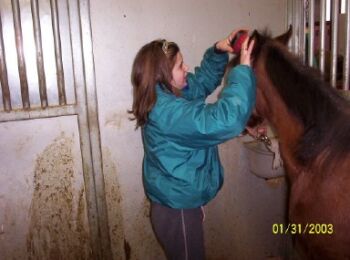
-
- We will continue to update Baby Farana's
Story as his healing progresses.
-
- Update: March 22,
2003
-
- The brace is here! The following pictures
show the afternoon's work on "brace day".....
-
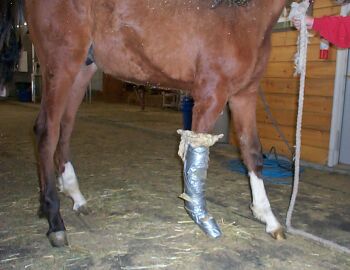
- Here is the makeshift support that has
been "getting him by" while we waited for the brace.
He has a short cast on his cannon under all that duct tape, and
a cotton wrap support over his knee. He has pulled off his plastic
shoe, and has his foot somewhat supported by duct tape as well.
We were READY for the arrival of the brace--can you tell?
-
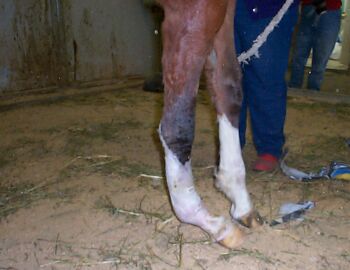
- Here's how he looks with no support at
all. Cannon fracture is well-healed and can support his weight
(although the leg is enlarged and likely always will be). But
his suspensory apparatus is extremely stretched and is NOT supporting
him properly, either at the knee or at the fetlock.
-
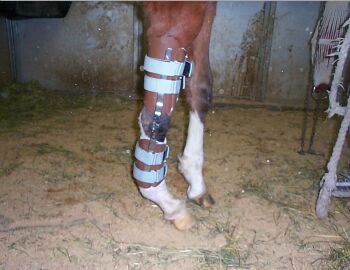
- Here he is in his new brace! It certainly
gives him the support he needs at the knee, and with the mobility
he can now have, hopefully the knee will regain strength as it
regains flexibility. It will only allow extension to the degree
that you can see in the photo, but will allow flexibility almost
to the range that he would have if the leg were normal. (The
brace was made by a company called Equine
Prosthetics.) But the laxity at the fetlock that allows the
pastern to drop is still a separate issue. Although he doesn't
look too bad just standing, it really drops when he walks, without
support from a corrective shoe.
-
- We looked into glue-on shoes that have
a cuff around the toe to help them to stay on. We found a great
product called Dalric shoes--they have a "Dalric D"
that is made to order for his condition, but only comes in foal
sizes, and alas, he is too big for the largest size. They also
have what is called a "Dalric Cuff" which could likely
have been adapted to a shoe for him--but alas, he is too small
for the smallest size of those. So we set out to build him a
shoe by reshaping a pony shoe his smaller hoof, which left us
with the trailers in back that we wanted for support. We welded
a "toe cage" out of plumbers' tape, and adapted some
keepers to hold a biothane heel strap in place. The finished
product looked like this:
-
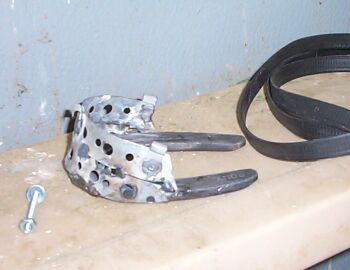
- And glued in place, it looks like
this:
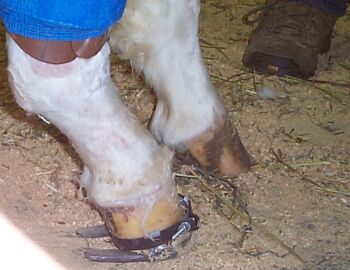
- He still sinks some when he walks, but
the shoe is making a substantial difference in how he places
his foot. He did manage to pull it off once (although we had
it likewise protected in duct tape). We've managed so far to
solve the problem by taping a baffle (half of the cardboard roll
from the inside of a roll of Vetrap) over the heels of the shoe
and behind his own heels, which makes it more difficult for him
to "grab" it with a hind hoof.
-
- We'll see how these aids work out for
him over the next few weeks, and will update again when we have
something new to report.
-
- Update: May 4, 2003
-
- Baby Farana came home from Payback Arabians
on April 15, 2003. Like a trooper, he hopped right into the trailer
for the 45-minute ride, knee brace and all. He wore the knee
brace pretty regularly for several weeks, but went temporarily
into a short Robert-Jones bandage while the brace went back to
Equine Prosthetics to be resized. (He's growing!) He continued
to wear it intermittently after it was resized, but has now pretty
much graduated to just a support wrap on the healed cannon. He
has also graduated from his special shoe, and travels with relatively
normal angulation and hoof posture, as well as no longer being
back at the knee. He still struggles with stress changes in the
knee on the other leg, but it is now easier to trim his "good"
foot, as he can now support himself on the healed fracture while
the other foot is picked up for brief periods, without having
to be put into his sling. We're hoping that supporting the over-stressed
knee and keeping the foot carefully trimmed will help the non-fractured
leg to recover from some of the damage it has sustained.
-
- Meanwhile, Baby Farana bucks and plays
in his paddock--and he is certainly enjoying being able to be
outdoors in a 16 x 32 paddock instead of locked in a box stall!
-
- Update: Early July, 2003
-
- Baby Farana is now free of all
wraps or supports. He can stand easily to have his feet trimmed,
and he runs and bucks in his paddock. He continues to be a sweetheart
and "pocket pet" after all the intensive attention
he has received. He is growing like a weed, and while he will
never be sound, he seems to be well on his way to growing up
to be a breeding stallion. He's a happy boy, and he's alive!
-
- Update: February, 2004
-
- Baby Farana is growing rapidly,
and has become a tall, gawky adolescent. Our biggest challenge
with him is keeping his front feet adequately trimmed--because
his fractured cannon healed shorter and a bit twisted, he puts
abnormal stresses both on the foot on the right front leg with
the healed fracture and on the knee on the opposite leg. Consequently,
he requires frequent trims to minimize the tendency for his front
feet to grow crooked and to alleviate the stresses on his joints.
But in all other aspects, he seems to be a normal rising two-year-old
colt.
-
- Update: November, 2004
-
- Although it is not usually our
policy to breed 2-year-old stallions, we decided that in the
case of Baby Farana, we should make an exception. We have been
very concerned about using him for live cover, given his injuries,
even though he is getting around well. After everything he has
been through, we just don't want to take the risk. We have had
his first mare chosen for quite some time -- Lizzie Bel (Belesemo
Trad x Naliza) on lease to us from Michael Bowling at New Albion
Stud. Lizzie brings in a cross to Farana's full brother Sikin,
and her fourth dam is Farana's full sister Farnasa. Lizzie is
the very sort of mare that we'd like to perpetuate in our program
and she complements Baby Farana very well.
-
- On September 22, we made our first
attempt to ground collect Baby Farana. He was curious about the
mare and was quite easy to handle; he was not afraid of the AV,
and didn't mind having his humans in close proximity supervising
his teasing routine. But he just couldn't quite figure out what
we wanted! The following day, Lizzie was still in a standing
heat with a good follicle, so we gave it another try. Eureka!
It looks like Baby Farana will be as easy to ground collect as
his sire was. And despite being just a long 2-year-old in the
fall of the year, he gave us a pretty good collection. We AI'd
Lizzie, and in mid-October, we confirmed by ultrasound that she
is indeed in foal! So we are eagerly awaiting the first of the
"next generation" that we so fervently hoped for throughout
the long ordeal with Baby Farana.
-
- Below are two photos taken of
Baby Farana (not such a baby anymore!) on Nov. 1:
-
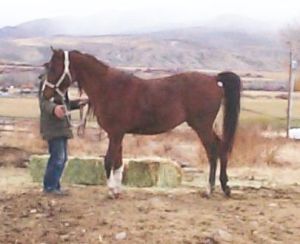
-
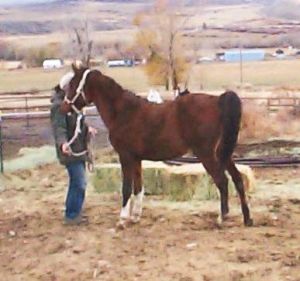
-
- You can get some idea of the irregularity
in the healed area of his right front cannon
- from viewing even these left-side
snapshots.
-
-
 |
- Heidi Smith, DVM
- PO Box 103
- Tendoy, ID 83468-0103
- Phone (208) 756-6060
|
|
![]()
![]()
![]()
![]()
![]()
![]()
![]()
![]()
![]()
![]()



.jpg)
